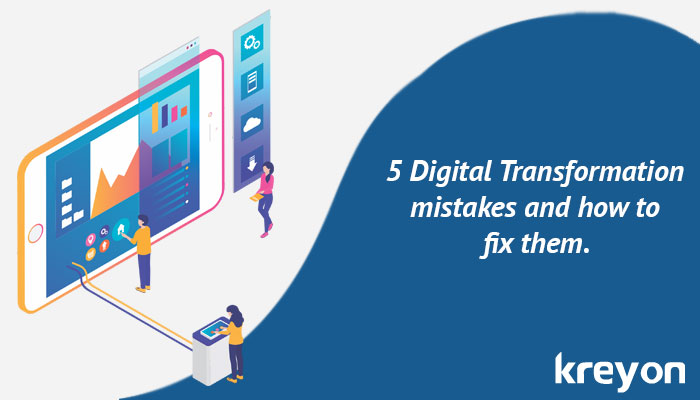5 Digital Transformation mistakes and how to fix them

The digital technologies are empowering companies to use technology to transform their operations, respond swiftly to customers, and augment new business models for additional revenue.
In a Forrester study, executives predicted that by 2020, 47% of revenue will be influenced by digital technologies. The digital technologies are taking over traditional businesses and companies are looking at transformation strategies to adapt.
How businesses prepare for the digital onslaught will dictate their future. The organisations that are lagging behind and not adapting fast enough are losing ground. Digital transformation is a key necessity in today’s world.
There are many companies that have undergone digital transformation successfully. For e.g. Domino’s Pizza now allows customers to place orders from anywhere and any device. Walmart has emerged as a leading ecommerce platform to complement its retail stores in recent years. Bank of America has introduced self service apps for its customers.
But, not all businesses are able to succeed in their digital transformation. In this post, we look at some of the digital transformation mistakes that companies make and how they can overcome them:
1. Starting without Clear Goals & Objectives
Digital transformation is not about technology, it’s about your business. Organisations should clearly define the end goals and objectives for their business when undergoing changes.
When the goals and objectives are not well defined, it leads to chaos and confusion. Digital transformation that doesn’t translate end to end processes creates hurdles for the customers as well as internal teams.
The solution: Organisations that succeed in digital transformation outline the key focus areas. They outline the metrics in terms of customer experience, internal processes, efficiency and bottom line. Well defined goals and structured approach to digital transformation leads to successful outcomes.
When operations are digitized, it shouldn’t leave gaps. Whether it is customers or employees, no one likes inconsistencies. The process digitization should be consistent across online and offline interactions.

2. Unrealistic Deadlines
The digital transformation requires careful planning and automation. Organisations that want to do too much too soon end up paying a heavy price for it. Digitization works best when it is done in phases. When everything is done in one go, it leads to panic.
The solution: To keep your digital transformation on track, plan and prepare well. It works well when you do it in phases and milestones. For e.g. customer interactions and support can be digitised first. Next you can focus on sales and support.
Customer loyalty, retention, employee onboarding, product digitization and other areas can be strategically pursued with key performance metrics. Breaking down digital transformation leads to improved outcomes. It doesn’t overwhelm the team, nor the customers.
3. Poor Communication & Understanding
Digital transformation requires everyone’s involvement. When top executives, board members and management is not involved in driving changes, it can create trouble for companies.
A disconnect between the board and people who are implementing the digital transformation introduces gaps. Poor communication can lead to misalignment of teams, wrong focus areas and ultimately disastrous project outcomes.
vision and purpose of the project.
The solution: Digital transformation requires creating leadership at all levels. It means connecting with teams, clarifying project objectives and conveying the purpose of the project.
The top level management should be involved in driving the changes, they should also be in touch with the people working on the ground to avoid disconnect. Good communication is about seeking feedback from customers and employees throughout the journey.

4. Moving too Slowly
The technology you build today will be outdated tomorrow. There is no respite from competition in the world today. One of the prime objectives of digital transformation is to make organisations more agile and fast paced to deal with ongoing disruptions in the world. Slow and sluggish developments can lead to stagnation and derail the projects. The speed of transformation is crucial to its success.
The solution: Streamline your processes and identify the bottlenecks early. Getting bogged down and not making progressive moves will hurt your company in the long run. Employees and all internal teams should understand that the price for not doing things on time can be fatal.
Work on optimising the schedules for projects by using the latest tools and technologies that can fast track processes and developments for your company. For e.g. companies are adopting design thinking software solutions, DevOps and test driven developments to improve their engineering efforts.
5. Copying Others & Doing it Yourself
Digital transformation is not about copying others. It is about understanding how technology can improve your core business operations. A lot of companies try to do everything themselves and end up with mediocre results. You cannot build a digital enterprise by copying what others are doing.
The solution:
Businesses need to work with teams that have the skills and expertise required for a successful digital transformation. Engaging experts with deep knowledge of technology and working with them to achieve your desired business goals can lead to better results.
Instead of assigning new roles to the current team members, trying to source individuals in house, it is often better to work with dedicated teams and a trusted digital partner with deep expertise.
Your digital transformation efforts can go awry because of experience, skills and may eventually fail without expertise in execution. Solid experience and expertise can make the difference the success and failure of your digital transformation.

Kreyon Systems is the preferred digital transformation partner for organisations around the world. If you are looking for any help or have any questions on digital transformation, please get in touch with us.
